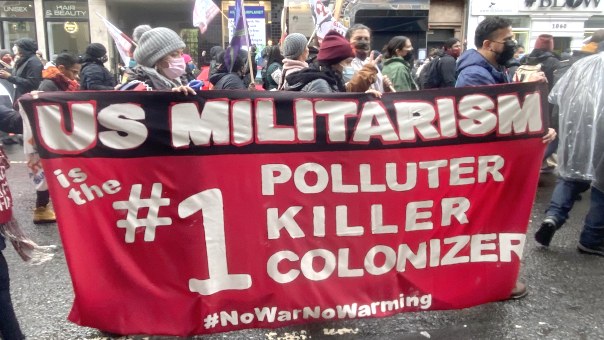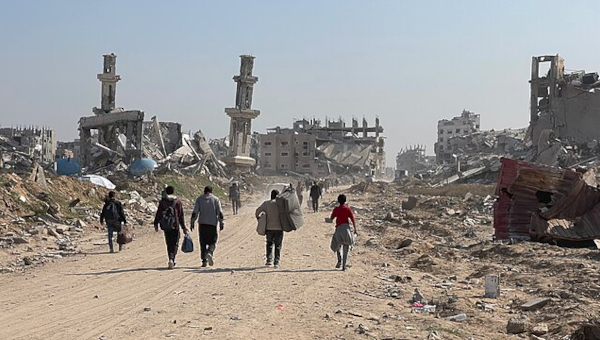Not A Peaceful Climate
With about ten active wars globally and the rearmament of the world, the global arms industry needs to be taken into account when talking about climate change and environmental destruction in general. However, in a world where so called ‘green’ parties participate in the arms industry and occasionally even speak the language of this industry, the connection is often lost. This text is not to discount the immense human suffering caused directly by war. While there are enough reasons to promote peace without this aspect, talking about environmental damage adds another indirect dimension. Climate neutrality can only be achieved through peace and cooperation at an international level.
War has an enormous ecological footprint and the greenwashing of it is ridiculous. An example of a shameful attempt at greenwashing is the manufacturing of an electric (military) tank in Flensburg, Germany. The production of such a tank alone consumes enormous resources and the whole concept of an ‘e-tank’ is a mockery of the climate movement, which historically has clearly been part of the peace movement. Carbon dioxide equivalent (CO2eq) neutral wars are fantasies without any scientific basis. Even if a tank could be produced in a climate-neutral way, it is still an instrument of destruction. Civilian buildings are also always destroyed, and their construction requires resources.

Military’s Footprint
The exact footprint of the military is unclear. If it were a country, the Pentagon alone would be in the top ten global polluters given its emissions. That means it can easily be said that the entire war machine, without even accounting for the costs of destruction through acts of war, is a leading cause of climate change and that there is no real path to climate neutrality ahead. The new course of Germany is exemplary for this since the country long took pride in its asserted ‘climate leadership’. While it still retains its image of being an environmental state, reality shows different priorities.
How to stay within the Paris Agreement with a 2% GDP target for NATO is not only unclear because the current government cannot present a green strategy; it is in any case also impossible. Either we stick to the specific Paris Agreement, which is actually binding, or stick to the non-binding 2% target. It is a simple trade-off, since pretending to aim for both is preposterous. A fact that is unfortunately exemplified in the answers to a parliamentary inquiry by DIE LINKE, which casts serious doubt on whether there is any such attempt.
The German government could not provide an answer to this question: “What development in annual energy consumption and energy costs does the Federal Government anticipate in the context of achieving NATO’s two per cent target?” In a similar vein, they did address the goal of climate-neutral fuel, saying that this is only partially possible, but mostly ignored the fact that the production of tanks, drones, etc. alone is associated with enormous environmental costs. There simply was no answer regarding the ecological footprint of production. Rather, it was pointed out that manufacturers are not obliged to provide information on resource consumption, but that voluntary information could bring manufacturers market advantages. There was not even an answer to the question of energy consumption in active duty. Rather than assuming that the military is just unaware, it is likely that such statistics do not exist on purpose. Especially, since the Pentagon, for example, already knew about climate change in the 1980s. And, once we look at guesstimates by scholars, the argument for wilful ignorance becomes stronger.
Mike Berners-Lee estimates the direct emissions from the Iraq war (2003-2009) at 250-600 million tonnes of CO2eq (Berners-Lee). That was up to eight months of the UK’s total consumption. It is clear that the direct costs cannot easily be calculated, and the methodology does not provide a well-founded estimate for the indirect costs. It can, however, be assumed that current warfare is not more climate neutral. Given that numbers are hard to obtain, we can only speculate. It is fair to assume that the military spending translates into higher emissions per dollar than most other spending. If the average German emissions are about 0.18 kg per dollar, the minimum emissions from its military in 2021 would be at least 9.1 million tonnes annually (Verteidigungsministerium).
The additional €100-billion military budget as a reaction to the Russian invasion translates to a minimum of 19.34 million tonnes of extra CO2eq emissions. The numbers sound insane, as do the predictable effects. Goodbye, habitable planet! We, therefore, must once again ask governments about the compatibility of the 2% target and the Paris Agreement.
Climate change itself is a trigger for wars (Lagi, Bertrand, Bar-Yam) and, at the same time, wars are one of the greatest burdens on the climate. More than ever, it is therefore important to work consistently on building peace. The use of weapons fuels the spiral of suffering. Sustainability needs peace more than ever. Climate policy can also be an opportunity to re-establish the role of a peace policy, which, after being forgotten, has suffered immensely in the last year given a very one-sided discourse of power politics only. •
Note from the author: Here, it is disrespectful to pit the victims of wars against the suffering and dying of people due to climate change, especially since war and climate change are interrelated and there is no hard evidence that bigger militaries lead to more peace, rather the contrary, even if environmental pollution were not relevant.
References:
- Berners-Lee, Mike (2010): How Bad are Bananas? The Carbon Footprint of Everything, 169f.
- cp. Verteidigungsministerium 2023. Bundesministerium für Verteidigung, www.bmvg.de.
- Lagi, M.; Bertrand, K. Z. and Bar-Yam, Y. (2011). The Food Crises and Political Instability in North Africa and the Middle East.
This article first published on the transform! Europe website.





